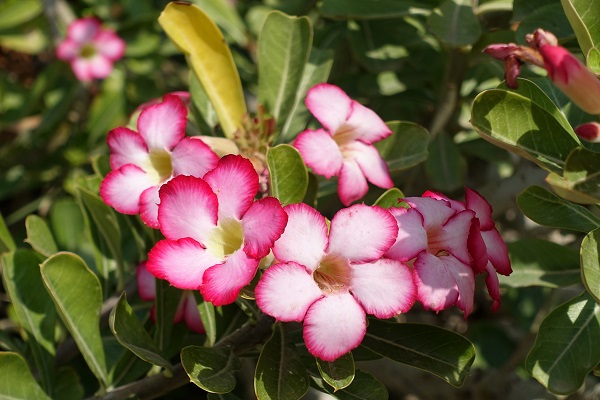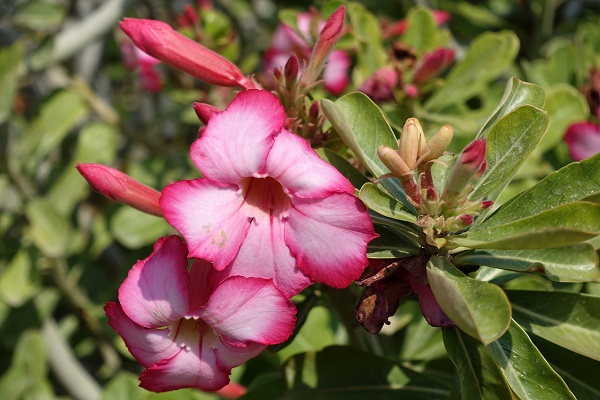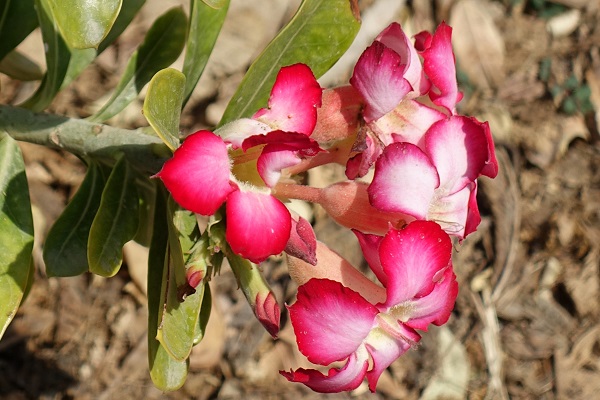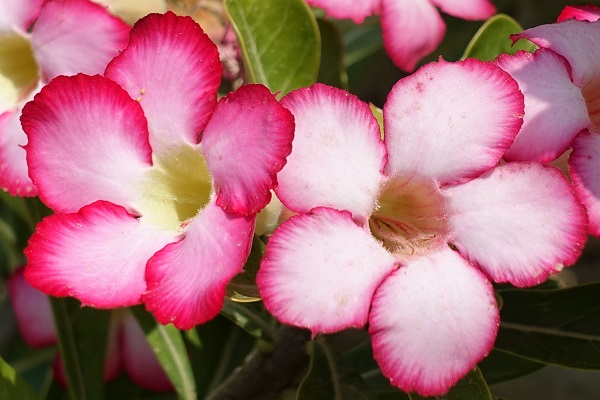Adenium honghel, Nerium obesum,
Desert-rose, Impala-lily, Mock azalea,
Hebrew: אדונית המדבר, ורד המדבר, Arabic: نبتة العدنة
| Scientific name: | Adenium obesum (Forssk.) Roem. & Schult. | |
| Synonym name: | Adenium arabicum Balf.f., Adenium arboreum Ehrenb., Adenium coetaneum Stapf, Adenium honghel Lindl., Nerium obesum Forssk. | |
| Common name: | Desert-rose, Impala-lily, Mock azalea | |
| Hebrew name: | אדונית המדבר, ורד המדבר | |
| Arabic name: | نبتة العدنة | |
| Family: | Apocynaceae, Dogbane family, הרדופיים |

|
| Life form: | Succulent, deciduous shrub or small tree; up to 4 metres tall, sometimes with a fleshy taproot. | |
| Stems: | Swollen at base up to 1 (-2) m in diameter; bark pale geyish-green, grey, brown, smooth with sticky, clear or white latex; branchlets glabrescent, pubescent at apex | |
| Leaves: | spirally arranged, clustered toward the tips of the shoots, simple entire, leathery in texture, 5–15 cm (2.0–5.9 in) long and 1–8 cm (0.39–3.15 in) broad | |
| Inflorescence: | a more or less terminal cyme | |
| Flowers: | Tubular, 2–5 cm (0.79–1.97 in) long, with the outer portion 4–6 cm (1.6–2.4 in) diameter with five petals, resembling those of other related genera such as Plumeria and Nerium. The flowers tend to red and pink, often with a whitish blush outward of the throat. | |
| Fruits / pods: | Follicle, dehiscent dry fruit | |
| Flowering Period: | May, June, July, August, September | |
| Habitat: | Dry bushland, semi-desert scrub, dry woodland and wooded grassland | |
| Distribution: | Cultivated as an ornamental plant. | |
| Chorotype: | Eastern Africa to Southern Arabia | |
| Summer shedding: | Perennating |

Derivation of the botanical name: Adenium, Latinized Arabic name Aden; the first species was collected in Yemen, at Jebel Melhan. obesum, Latin, fat, stout, plump. coetaneum , "having the same age as another, beginning to exist at the same time," c. 1600, from Late Latin coaetanus "one of the same age." honghel, was found to contain cardiac glycosides: Honghelin, Hongheloside A & C, Digitalinium, Verum. Nerium, Oleander. Rose bay. The classical Greek name.


|